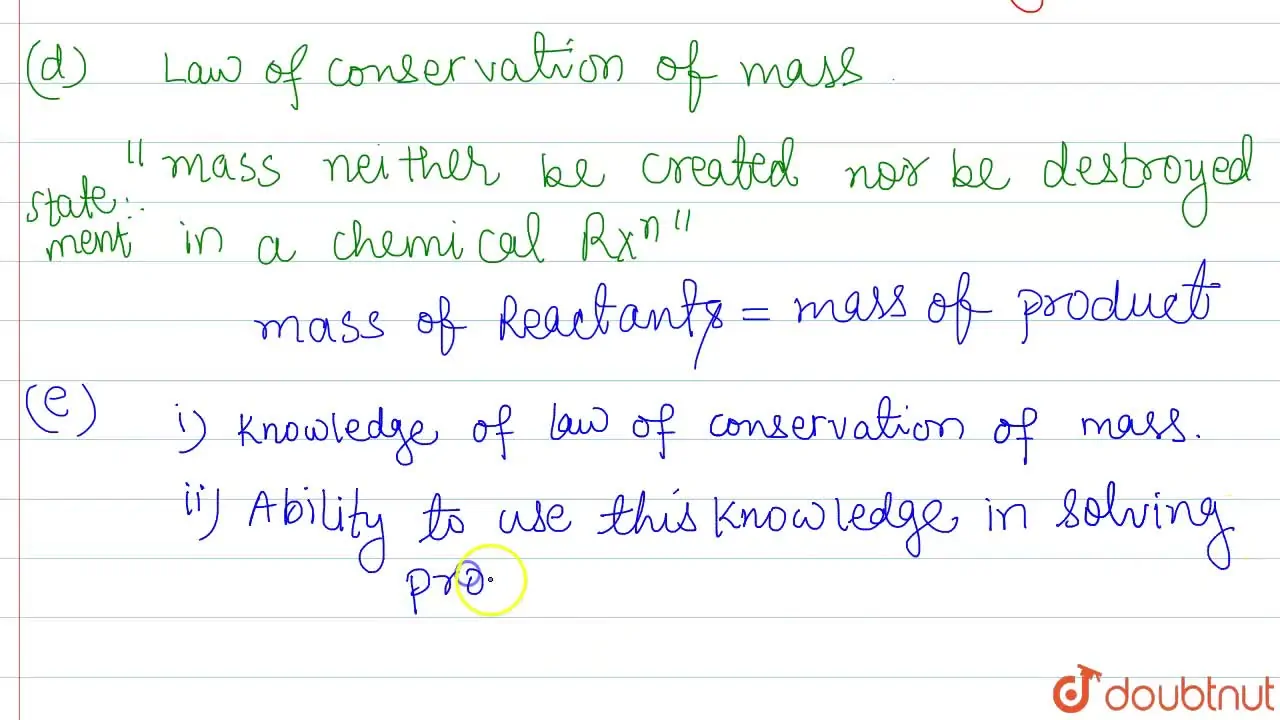One day Vabhav was performing experiments in the science laboratory based on the of chemical combination. Just then his chemistry teacher, Mr. Rajeev, came into the laboratory. Mr. Rajeev told Vaibhav that in an experiment conducted byby a class IX student when 10.6 g of sodium carbonate was reacted with 12.0g of ethanoic acid in a closed flask, then 16.4 g of sodium ethanoate, 4.4 g of carbon dioxide and an unknown mass of substances Y were produced. Mr. Rajeev asked Vaibhav to make use of this information and answer the following questions :
(a) Write a word equation for the reaction which takes place on reacting sodium carbonate and ethanoic acid
(b) Which is the substance Y which is produced in this reaction ?
(c) What mass of substance Y is produced in this reaction ?
(d) Which law of chemical combination has been made use of in calculating the mass of substance Y ? State this law
(e) What values are displayed by Vaibhav in this eposide ?
(a) When sodium carbonate and ethanoic acid react together, then sodium ethanoate, carnon dioxide and water are produced. A word equation for this reacion can be written as :
Sodium carbonate+Ethanoic acid→Sodium ethanoate+Carbon dioxide+Water (Y)
(b) The substance Y produced in this reaction is 'water'
(c) We will now calculate the mass of substance Y or mass of water produced in the given reaction. In this reaction, sodium carbonate and ethanoic acid are reactants whereas sodium ethanoate, carbon dioxide and water are products
Here Mass of reaction = Mass of sodium carbonate + Mass of ethanoic acid
=10.6g+12.0g
=22.6g.....(1)
Now, suppose the mass of substance Y is x
So, Mass of products = Mass of sodium ethanoate + Mass of carbon dioxide + Mass of water
=16.4g+4.4g+xg
=20.8g+xg ....(2)
Now, according to the law of conservation of mass :
Mass of products = Mass of reactants
So, 20.8+x22.6
And x=22.6−20.8
=1.8g
Thus, the mass of substance Y or mass of water produced is 1.8 grams
(d) (i) The law of conservation of mass in chemical reactions has been made use of in calculating the mass of substance Y or water
(ii) The law of conservation of mass states that in a chemical reaction, the total mass of products is equal to the total mass of reactants. There is no charge in mass during a chemical reaction
(e) The values displayed by Vaibhav in this episode are (i) Knowledge of the law of conservation of mass in chemical reactions and (ii) Ability to use this knowledge in solving problems.
Related Playlists
Similar Questions
Write chemical equations for the reactions of ethanoic acid with
sodium carbonateView Solution8.4 g of sodium bicarbonate on reaction with 20 g of acetic acid liberated 4.4 g of carbon dioxide gas into the atmosphere. What is the mass of the residue left?
View SolutionSodium carbonate reacts with ethanoic acid to form sodium ethanote, carbon dioxide and water. In an experiment, 5.3 g of sodium carbonate reacted with 6 g of ethanoic acid to form 8.2 g of sodium ethanoate, 2.2 g of carbon dioxide and 0.9 g of water. Show that this data verifies the law of conservation of mass.
View SolutionWhat happens when ethanoic acid is treated with sodium carbonate ?
View SolutionIn a reaction 6.0g of sodium carbonate were reacted with 10g of hydrochloric acid solution. The product was a mixture of 4.5g of carbon dioxide and 11.5g of sodium chloride solution. This data in agreement with the law of
View SolutionIn a reaction 5.3g of sodium carbonate reactants with 6g of ethanoic acid. The products were 2.2g of carbon dioxide, 0.9g water and some sodium ethanoate. What is the expected weight of sodium ethanoate?
View SolutionWrite chemical equations for the reactions of ethanoic acid with:
(i) sodium, (ii) sodium carbonate.
(iii) ethanol in the presence for conc. H2SO4.View SolutionEthanoic acid is treated with sodium carbonate. Give balanced reaction.
View SolutionWhat happens when ethanoic acid is treated with sodium bicarbonate ?
View SolutionIn a reaction 4.0g of sodium carbonate were reacted with 10g of hydrochloric acid solution. The product was a mixture of 2.5g of carbon dioxide and 11.5g of sodium chloride solution. Is this data in agreement with the law of conservation of mass?
View Solution


